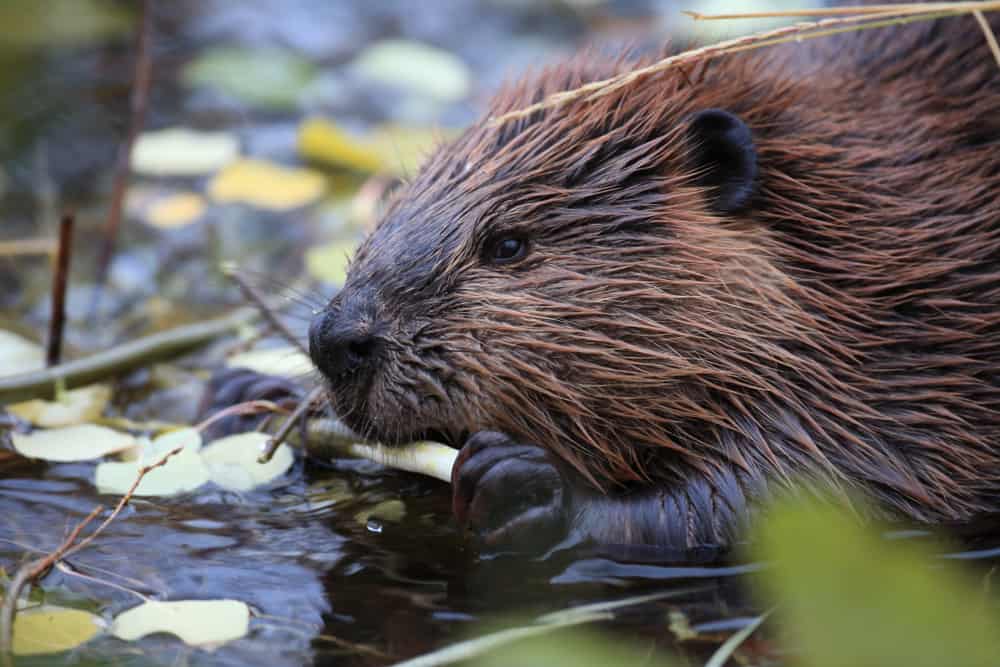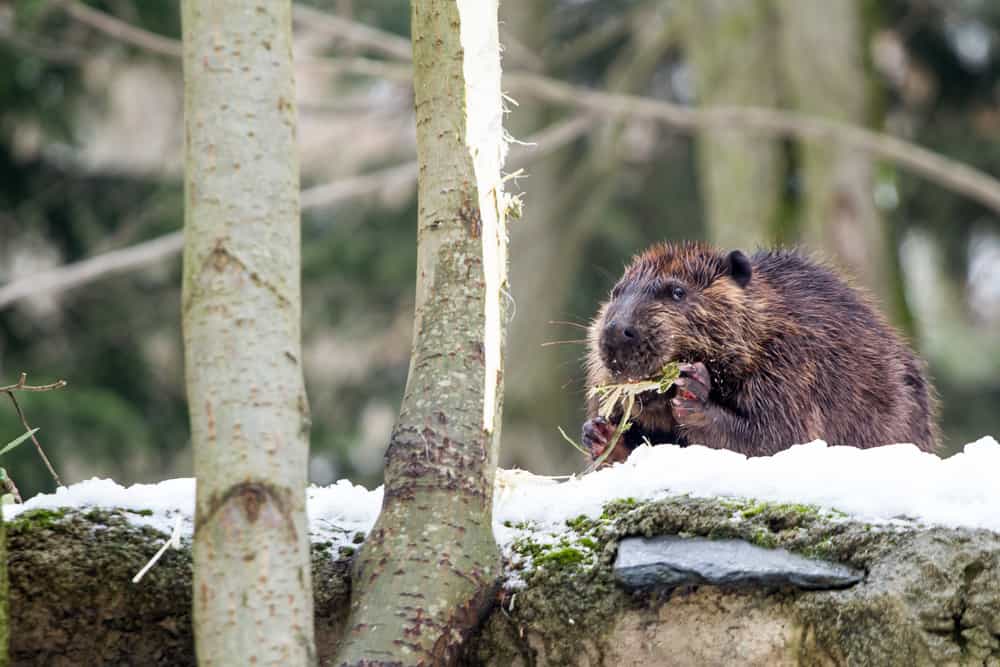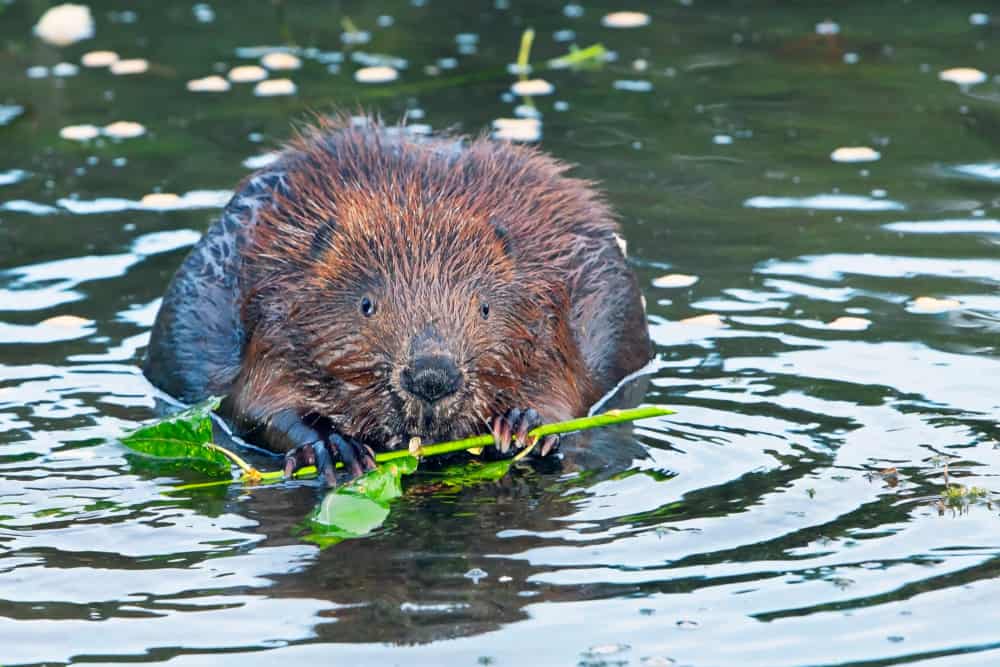North American beavers are the largest rodents in the US. Native Americans respected these ‘little people’ because they managed to alter local habitats to fulfill their needs. You have probably known that these semiaquatic animals can move on the land and water equally, but let’s see what do beavers eat.
Beavers Habits and Biology
Beavers are nocturnal animals and usually look for food at night. In any case, they spend most of the day eating and building dams. An average beaver can cut down about 215 trees a year. Some of them are up to 15.5 inches (39 cm) in diameter. Their dams can reach an impressive 50 feet (5 m) in height.
North American beaver
The North American beaver (Castor Canadensis) with an impressively long tail is the largest rodent in the US that weighs 45 to even 100 pounds (20.5 – 45.5 kg). It usually grows to 30 to 45 inches (76 cm – 1.1 m), with a 10 to 20 inches (25.5 – 51 cm) long tail.
This animal’s diet directly depends on its long, dark orange incisors that don’t stop growing throughout its lifetime.
You can quickly recognize beavers thanks to their furry, yellow-brownish coat with a black hue and long, scaly, and flat black tail. That tail allows the animal to balance and swim, but it also uses it as an alarm in danger.
Beavers |
||
| Scientific classification | North American beaver | Eurasian beaver |
| Kingdom | Animalia | Animalia |
| Phylum | Chordata | Chordata |
| Class | Mammalia | Mammalia |
| Order | Rodentia | Rodentia |
| Family | Castoridae | Castoridae |
| Subfamily | Castorinae | Castorinae |
| Genus | Castor | Castor |
| Species | Castor canadensis | Castor fiber |
Eurasian beaver
The Eurasian beaver (Castor fibre) is a bit smaller species than its American cousin and usually weighs 20 to rarely 75 pounds (9 – 34 kg). Its length ranges from 30 to 40 inches (76 cm – 1 m) with a 10 to 20 inches (25.5 – 51 cm) long tail.
This rodent has two coat layers, including a gray undercoat and a long red-brown outer layer.
After extinction in Scotland about 400 years ago, this beaver type was introduced from Norway and formally recognized as a native species. Interestingly, this animal was widely distributed in Great Britain in the past, but none was found in Ireland.
Do Beavers Eat Dirt?
Unlike other rodents, beavers are picky eaters with a specific taste for food. They never eat dirt and soil or steal garbage from someone’s trash can.
Even though they often cut down big trees, you will never see these animals consume all the trees parts. They prefer soft leaves, inner bark, and shoots and use hardwood for their construction endeavors. Can you imagine that only one beaver can fell approximately 300 trees a year? Quite impressive, isn’t it?
What Do Beavers Like to Eat Most?
These large animals from the order Rodentia are mostly herbivorous with a unique ability to digest cellulose, so they enjoy nibbling woody plants. Only consuming the top food helps beavers to stay healthy. The best option for these animals are:
- Inner bark – Soft woody plants’ inner bark is a beaver’s primary food source, particularly in a cold period from fall to spring. They prefer aspen trees but will also enjoy eating alder, willow, birch, and cottonwood bark.
- Leaves – Beavers often eat leaves as an excellent source of nutrients during summer. In that period, beavers will reduce bark intake to only 10%.
- Twigs – You can sometimes see beavers consume soft and sometimes dead twigs when necessary.
- Shrubs and ferns – You can expect beavers to consume more shrubs and ferns in summer.
- Aquatic plants – This semi-aquatic animal will always gladly pick out aquatic plants as an essential part of its diet. The favorite ones include cattails and lilies’ roots and stems.
- Grass and crops – Beavers like crops leaves and stems, especially corn and beans, making a problem for local farmers.
As I have already mentioned, you can recognize two beavers types with similar eating habits. Let’s take a look.
North American beaver diet
- Aquatic plants like water lilies and watercress
- Willow, birch, aspen tree, alder, maple, cottonwood, apple tree, cherry tree, and poplar woody stems
- Oak and black cherry when needed
- Leaves, inner bark, vines
- Sedges, giant ragweed, grasses, shrubs, cattails, ferns, apples, clover, and blackberry canes when they predominate in the environment
- Sagebrush when other vegetation is sparse
Eurasian beaver diet
- Aquatic plants, including myrtles, water lilies, and cattails tubers and the rootstocks
- Birch, lime trees, willow, black poplars, hazels, and aspen trees’ twigs
- Leaves, buds, and shoots
- Roots and soft inner bark
- Blackberry vines, pondweed, scrub plants, wild fennel, and even mushrooms
- Crops like corn and beans when needed
Thanks to specific microorganisms in their cecum, beavers have a unique ability to digest cellulose. While other mammals can’t decompose this nutrient at all, these rodents can digest about 30% of consumed cellulose. Other plants will provide their energy levels and maintain their body weight.
They also have a disgusting habit of eating their own droppings, but it is an excellent way to stay well-fed by absorbing more nutrition from food.
Interestingly, beavers’ diets will vary depending on the season. They eat soft and woody plants in spring and fall while choosing mostly soft food during hot summer days.
As you can guess, they will take more wooden plant parts in winter. They store this supply in a so-called cache on a muddy floor inside their lodges.
Kits (baby beavers) suckle their mothers’ milk like other mammals. After approximately six weeks, they start eating solid beaver food. Young beavers live with their families for about two years on average.
Food Avoid to Feed Beavers
As I have already mentioned, beavers are herbivores and never eat meat and fish. However, they will refuse to consume some plants, as well. Let’s see what these animals don’t like eating and why.
Tree parts – In most cases, beavers don’t eat trees after cutting them down. Precisely, they only consume some tree parts, preferably the cambium, the soft inner bark.
Some deciduous tree types – Beavers prefer deciduous trees but never eat alder and oak trees. They are only for construction purposes. For some reason, these rodents will also avoid:
- Ninebark bush
- Cascara trees
- Twinberry trees
- Osoberry trees
- Elderberry trees
Berries – Beavers won’t happily eat most berry plants from wetland and blackberry canes. Only a great famine can make them chew this food type.
Conifers – When a beaver is really hungry and there is no other food available, it will eat conifers like fir, hemlocks, Sitka spruce, and pine. However, it doesn’t like them at all.
Fish and meat – Never expect beavers to consume fish, meat, and meat products. These animals are herbivores (strict vegetarians), so you will never see any of them eat such food.
Leftovers – Beavers are not omnivores and will never eat leftovers from your meal. Digging in trash cans is definitely not their style.
Tips to Feed Beavers
How often these rodents eat depends on their body size, activity level, and the season. An adult beaver needs approximately 3.5 to 4.5 pounds (1.5 – 2 kg) of food a day during the summer. However, it reduces that amount to only 2 pounds (0.9 kg) a day in winter.
Beavers that live in the northern regions store food in deep water close to their lodge and cover it with a layer constructed of leafy branches. That supply collected in a food cache allows them to survive the winter when there is a food shortage while storing technique keeps food safe from freezing.
However, beavers that live in regions with moderate climates often don’t need to store food.
These rodents usually have their meals in late afternoons. A period between afternoon and dawn is ideal for building dams and collecting food. However, they can eat whenever they want when spending time inside the lodge.
When winter is mild and warm days come in early spring, beavers come out from their silent aquatic world to look for fresh woody stems. That is a moment when they change a woody diet with more delicious herbaceous meals.
Once their supplies run out or food sources become reduced in the area, beavers will move to better locations. In most cases, they do it every few years, which is actually excellent for both these animals and the environment.
Beavers will find new food sources while nature gets time to recover and regenerate. Once the new place becomes inappropriate, beavers will often head back to the previous location.
Most scientific studies show that beavers’ affection for the fish population is negligible. Even though they never eat fish, their dams can block some fish species migration and consequently decrease their population.
Summary
Beavers are on the brink of extinction in a large number of states due to endangering their habitat. Luckily, people start paying attention and take care to protect them. A healthy diet is a significant part of beavers’ lives, so it is crucial for them to find necessary wood plants, grass, and aquatic plants to survive.


